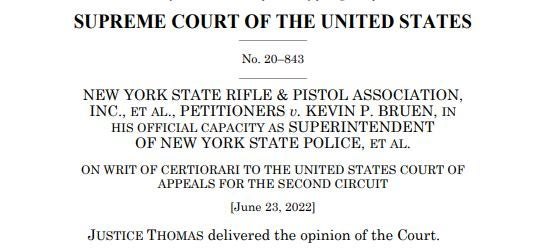The 2022 Supreme Court of the United States (SCOTUS) session resulted in several decisions impacting gun ownership. What exactly these cases mean and how they will impact gun regulation in America is not totally clear, but some points are fairly certain. An in-depth discussion of the nuance of these cases would be an entire book, and is far beyond the scope of one article. We will instead keep this a surface-level discussion.
Disclaimer: This is not legal advice. If you are making decisions based on this information, you need to stop and talk to a lawyer about your specific situation. This article is just one lawyer/gun nerd’s take on what these cases mean.
Legal Analysis – 2022 Supreme Court Gun Cases, Explained

Analysis – 2022 Supreme Court Gun Cases, Explained
NYSRPA v. Bruen
The biggest gun case this year was the New York State Rifle and Pistol Association v. Bruen (Kevin Bruen is the Superintendent of the New York State Police). Like some states, New York has required concealed carry permit applicants to show a “good cause” before issuing the permit. Self-defense by a general member of the public was not considered a good cause. NYSRPA challenged that requirement, and SCOTUS agreed with them. The practical outcome of the case is that states cannot require a permit applicant to show a heightened need for personal protection.
However, Bruen has far-reaching implications beyond concealed carry permits. Courts often apply “tests” to the facts of a case, which guides the court’s decision. Tests can be convoluted, but generally are a list of questions, and the facts of the case are used to answer those questions. These tests are usually created as part of the ruling in a case, and help other courts faced with similar situations in the future.
Bruen changed the test that courts should use in gun cases. To understand that change, we need to look at a previous Supreme Court gun decision. D.C. v. Heller is a 2008 Supreme Court decision that stated the Second Amendment applied to individuals, not just a collective militia. It also held that the right to keep and bear arms extends to weapons in common usage, but does not extend to abnormally dangerous or usual weapons.
Certain courts took the decision in Heller and used it as the first step of a two-step test. If the proposed law failed under the Heller standard, the court would apply “intermediate scrutiny,” which means the law must further an important government interest and be substantially related to that interest. In essence, courts would say “well, this law isn’t compatible with Heller, but we still think this law is important so it is ok.”
Bruen specifically ended the two-step test.
Today, we decline to adopt that two-part approach. In keeping with Heller, we hold that when the Second Amendment’s plain text covers an individual’s conduct, the Constitution presumptively protects that conduct. To justify its regulation, the government may not simply posit that the regulation promotes an important interest. Rather, the government must demonstrate that the regulation is consistent with this Nation’s historical tradition of firearm regulation. Only if a firearm regulation is consistent with this Nation’s historical tradition may a court conclude that the individual’s conduct falls outside the Second Amendment’s “unqualified command.” Konigsberg v. State Bar of Cal., 366 U. S. 36, 50, n. 10 (1961).
This is a massive change from the status quo, and it signals the end of many gun control laws around the country. In fact, several cases that were up for possible Supreme Court review have already been impacted by this decision. SCOTUS has issued “grant, vacate, remand” orders on several gun cases, including Duncan v. Bonta (challenging California’s magazine ban), Bianchi v. Frosh (challenging the Maryland assault weapon ban), Young v. Hawaii (challenging Hawaii’s firearm carry law), and Association of New Jersey Pistol and Rifle Clubs v. Bruck (challenging New Jersey’s magazine ban). These “grant, vacate, remand” orders mean the Supreme Court grants the petition to hear the case in question, the lower court’s previous decisions are vacated (meaning they are no longer a binding precedent), and the case is remanded (sent back) to the appeals court for a new decision based on the Bruen decision. This is a very strong indicator that these cases will go in favor of expanded gun rights, but don’t count on a victory until one happens. Lawyers and judges can be very creative when they want to be.
Administrative Law Cases
A few other Supreme Court cases may end up impacting gun regulation, even if they are not gun cases. To understand how those cases work we have to first explain what administrative agencies and rules are. If you are already an expert in the Code of Federal Regulations, please feel free to skip ahead.
Congress creates laws. The Judiciary interprets those laws. The Executive branch enforces those laws. While that sounds like a simple setup, in practice it can get extremely complicated. Let’s say Congress wants to reduce pollution so they pass a law banning “abnormally hazardous chemicals.” Congress is not made up of chemists and biologists who are experts in that field, nor does Congress have the time to argue the vagaries of which specific chemical compounds are abnormally hazardous or just plain hazardous. Instead, Congress empowers an agency in the Executive branch to figure out which chemicals are abnormally hazardous, and to publish rules listing those chemicals. As scientific understanding changes and new chemicals are created, the agency can issue new rules about those chemicals without Congress getting involved.
Unfortunately, the system often does not work as intended. It is common for courts to defer to an agency’s opinion Some agencies make rules that directly contradict the law they are supposed to be interpreting and applying. One such agency is the Bureau of Alcohol, Tobacco, and Firearms. They are a regulatory agency, and they have a history of making questionable administrative rules.
Two recent cases have reined in administrative agencies. American Hospital Association v. Becerra dealt with the Department of Health and Human Services, and their ability to set reimbursement rates for health care. The Supreme Court justices found, unanimously, that HHS had misinterpreted the law they were attempting to apply. Court precedent allows generally leans toward trusting an agency’s opinion on laws. But in this case, the Court ignored the opinion of HHS and looked at the plain meaning of the law instead.
West Virginia v. EPA deals with coal and natural gas power plants. The EPA created a rather broad rule about power plants, which would eventually phase out the plants in question. SCOTUS ruled that the EPA did not have power from Congress to make that rule, and, as such, it was struck down.
So how do hospital and power plant regulations impact gun laws? In short, these cases will make it harder for the ATF to ignore underlying laws when making rules, or to make rules that are outside their authority. One specific example is in the bump stock cases. ATF created an administrative rule defining bump stocks as machine guns, despite the fact that the plain meaning of the law says bump stocks are not machine guns. The upcoming rule on pistol stabilizing braces and the recent rule on 80% lowers will probably not survive under these recent decisions.
Conclusion
The 2022 Supreme Court term was positive for gun owners. Immediate impacts are already being felt, such as the California AG directing the state to drop the “good cause” requirement for concealed permits. Other impacts, like increased scrutiny on administrative agencies, may take longer to impact gun cases. At this point, it is safe to say that SCOTUS challenges to gun laws have a high success rate.


